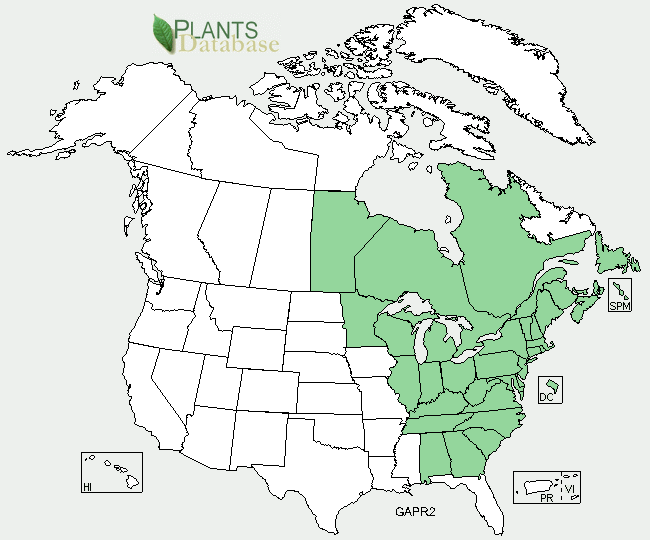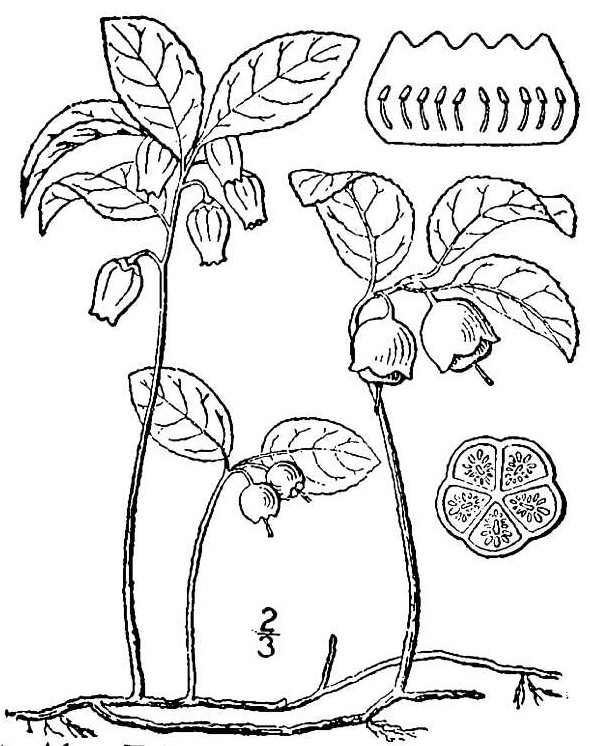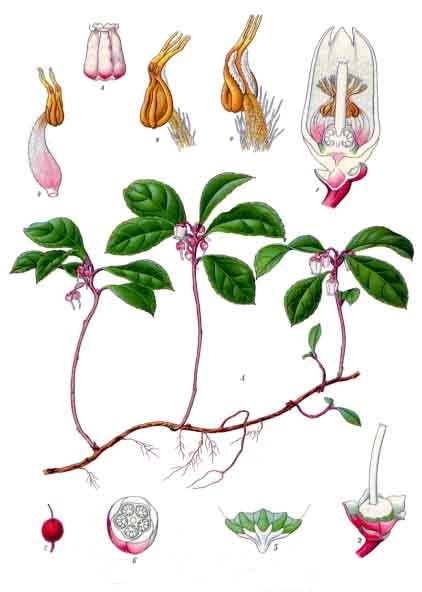Nature's Restaurant:
Fields, Forests & Wetlands Foods of Eastern North America
A Complete Wild Food Guide
Search Nature's Restaurant & Wild Foods Home Garden Websites:
Wintergreen Berries
Wintergreen with berries. (Dryas CC BY-SA 3.0)
Season: Late Fall & Winter
Urban, Rural or Both: Rural mainly
Wintergreen (Gaultheria procumbens). This plant has a remarkable number of common names which include: Eastern Teaberry, Checkerberry, Creeping Wintergreen, Boxberry, American Wintergreen, American Mountain Tea, Boxberry, Canada Tea, Canterberry, Chickenberry, Chinks, Deerberry, Drunkards, Gingerberry, Ground Berry, Ground Tea, Grouseberry, Hillberry, Mountain Tea, One-berry, Partridge Berry, Procalm, Red Pollom, Spice Berry, Squaw Vine, Star Berry, Spiceberry, Spicy Wintergreen, Spring Wintergreen, Teaberry, Wax Cluster, Youngsters. It even has extra Latin names: Brossaea procumbens & Gaultheria humilis. Certainly not an ignored plant by those who bestow names.
Caution: This plant, especially the leaves contain Oil of Wintergreen which is a high concentration of a natural Aspirin (an ester of salicylic acid). One ounce of Oil of Wintergreen contains the equivalent of about 170 adult Aspirin tablets. If you are allergic to Aspirin, don't consume any part of this plant. Also, consider eating the raw leaves poisonous. They are often made into a medicinal tea, but the toxic components are released when heated. Also, because of Reye's syndrome, children under 12 and teenagers should probably not eat these.
This low shrub is commonly found in low nutrient acidic soils in conifer woods. The name Wintergreen comes from the fact that the plant is not Deciduous, but is an Evergreen - keeps its leaves all season long, hence it is green in the winter, or Winter-green. The reason it does this is a response to growing in low nutrient soils - it would take a lot of nutrients and energy to regrow new leaves each spring.
They can be cooked and used in recipes, or a couple eaten raw while out in the woods. I have never gathered enough to cook, but do enjoy the clean minty taste when out walking in the fall or early winter.
Growing this plant in your home garden:
If you live where you have conifer trees, acid soils that are poor in quality, this is a great ground cover choice, plus you get the added bonus of having the berries. This is a slow growing plant - it grows where the soil is poor, but given the time, can establish in an area.
For detailed growing instructions, go to my Wild Foods Home Garden website Wintergreen page.
Description:
- Plant Size: Generally 10-15 centimeters (4 to 6 inches) tall
- Duration: Perennial creeping Shrub
- Leaf Shape: Ovate to Elliptic
- Leaf Phyllotaxis (Leaf Arrangement) on branch: Alternate
- Leaf Size: 2-5 cm (4/5 to 2 inches) long and 1-2 cm (2/5 to 4/5 inches) wide
- Leaf Margin: Entire to Serrate
- Leaf Notes: Leaves are Evergreen. Leaves have distinctive Wintergreen oil scent. Leaf surface is glossy. Leaves turn red to purple in fall.
- Flowers: Singly or raceme of 5 mm long bell or urn shaped 5 petal white flowers
- Fruit: Bright "Christmas" red, 6-9 mm (1/4 to 1/3 inch) diameter. Mint like flavor. Berries are ripe in September and stay on the plant until spring.
- Habitat: Tends to be found in conifer woods in acidic soils low in nutrients. If there is a lot of shade, don't expect berries, even if the plant is doing fine. Look for the berries in plants in the woods where a good amount of light reaches the forest floor.
- Recipe search on the web here (Google search) and here (Bing search).
- Pictures on the web here (Google images) and here (Bing images).
- USDA distribution map and plant profile here.
- The Biota of North America Program (BONAP) distribution map here. BONAP map color key here.

Wintergreen (Gaultheria procumbens) range. Distribution map courtesy of U. S. Department of Agriculture (USDA Natural Resources Service) and used in accordance with their policies.
Wintergreen with berries. (Dryas CC BY-SA 3.0)
Wintergreen in flower. (Jomegat CC BY-SA 3.0)

Drawing. (USDA-NRCS PLANTS Database / Britton, N.L., and A. Brown. 1913. An illustrated flora of the northern United States, Canada and the British Possessions. 3 vols. Charles Scribner's Sons, New York. Vol. 2: 693)

Color drawing. (Franz Eugen Köhler, Köhler's Medizinal-Pflanzen)
Search Nature's Restaurant & Wild Foods Home Garden Websites:
Why does this site have ads?
Originally the content in this site was a book that was sold through Amazon worldwide. However, I wanted the information to available to everyone free of charge, so I made this website. The ads on the site help cover the cost of maintaining the site and keeping it available.
Website Information:
This website was designed and written by me in HTML using the Bluefish 2.2.7 editor on Mint 18 Cinnamon Linux. I used the Bootstrap frontend framework, style sheets & Javascript.
This site is hosted by HostUpon. I am very thankful to them for all the patient technical support I received when I first set up my websites and had no idea what I was doing. I am happy to recommend them.
The site is designed to work with all browsers and is specifically designed to be highly functional on smartphones. I kept the site simple, with a clean page design to make using on a smartphone easy, quick & efficient. The Bootstrap framework is responsive, and automatically scales to any screen size.
If you encounter any problem using this site on any device, I would appreciate knowing. Let me know by using the contact page. Tell me what the problem is, and what device you are using it on.